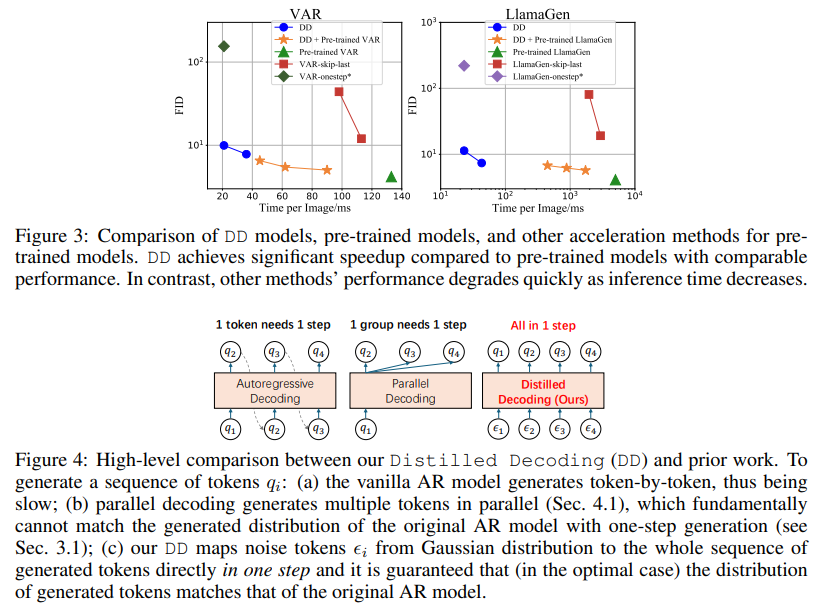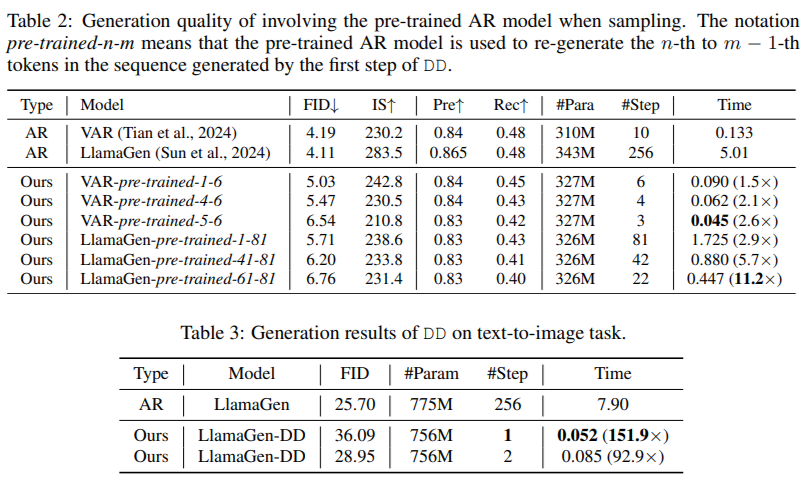Autoregressive (AR) models have changed the field of imaging, setting new benchmarks in the production of high-quality images. These models divide the image creation process into sequential steps, each token generated based on previous tokens, creating results with exceptional realism and consistency. AR techniques have been widely adopted by researchers for applications in computer vision, gaming, and digital content creation. However, The potential of AR models is often limited by their inherent inefficiencies, particularly their slow generation process, which remains a major obstacle in real-time applications.
Among many concerns, one criticism that AR models face is their speed. The token-by-token generation process is inherently sequential, meaning that each new token must wait for its predecessor to complete. This approach limits scalability and results in high latency during imaging tasks. For example, generating a 256×256 image using traditional AR models like LlamaGen requires 256 steps, which translates to about five seconds on modern GPUs. These delays make it difficult to implement in applications that demand instant results. Furthermore, while AR models excel at maintaining the fidelity of their results, they struggle to meet the growing demand for speed and quality in large-scale deployments.
Efforts to accelerate AR models have resulted in various methods, such as predicting multiple tokens simultaneously or adopting masking strategies during generation. These approaches aim to reduce the steps required, but often compromise the quality of the generated images. For example, in multi-token generation techniques, the assumption of conditional independence between tokens introduces artifacts that undermine the cohesion of the result. Similarly, masking-based methods allow for faster generation by training models to predict specific tokens based on others, but their effectiveness decreases when generation steps are drastically reduced. These limitations highlight the need for a new approach to improve the efficiency of the AR model.
Researchers from Tsinghua University and Microsoft Research have presented a solution to these challenges: Distilled Decoding (DD). This method is based on flow matching, a deterministic mapping that connects Gaussian noise to the output distribution of pre-trained AR models. Unlike conventional methods, DD does not require access to the original training data of AR models, making it more practical for implementation. Research showed that DD can transform the generation process from hundreds of steps to just one or two, while preserving the quality of the result. For example, on ImageNet-256, DD achieved a 6.3x speedup for VAR models and an impressive 217.8x for LlamaGen, reducing generation steps from 256 to just one.
The technical foundation of DD is based on its ability to create a deterministic trajectory for token generation. Using stream matching, DD maps noisy inputs to tokens to align their distribution with the pre-trained AR model. During training, the mapping is summarized into a lightweight network that can directly predict the final data sequence from a noise input. This process ensures faster generation and provides flexibility to balance speed and quality by allowing intermediate steps when necessary. Unlike existing methods, DD eliminates the trade-off between speed and fidelity, enabling scalable implementations across various tasks.
In experiments, DD highlights its superiority over traditional methods. For example, using VAR-d16 models, DD achieved one-step generation with an increase in FID score from 4.19 to 9.96, showing minimal quality degradation despite a speedup of 6. 3 times. For the LlamaGen models, reducing steps from 256 to one resulted in an FID score of 11.35, compared to 4.11 on the original model, with a notable 217.8x speed improvement. DD demonstrated similar efficiency on text-to-image conversion tasks, reducing generation steps from 256 to two and maintaining a comparable FID score of 28.95 vs. 25.70. The results underscore DD's ability to dramatically improve speed without significant loss of image quality, a feat unmatched by baseline methods.

Several key takeaways from DD research include:
- DD reduces generation steps by orders of magnitude, achieving up to 217.8 times faster generation than traditional AR models.
- Despite the accelerated process, DD maintains acceptable quality levels, and FID score increases remain within manageable ranges.
- DD demonstrated consistent performance across different AR models, including VAR and LlamaGen, regardless of their token sequence definitions or model sizes.
- The approach allows users to balance quality and speed by choosing one-, two-, or multi-step generation paths based on their requirements.
- The method eliminates the need for the training data of the original AR model.making it feasible for practical applications in scenarios where such data is not available.
- Due to its efficient distillation approach, DD can potentially impact other domains, such as text-to-image synthesis, language modeling, and image generation.

In conclusion, With the introduction of Distilled Decoding, researchers have successfully addressed the longstanding trade-off between speed and quality that has plagued AR generation processes by leveraging stream matching and deterministic mappings. The method accelerates image synthesis by dramatically reducing steps while preserving the fidelity and scalability of the results. With its strong performance, adaptability, and practical deployment advantages, Distilled Decoding opens new frontiers in real-time applications of AR models. Sets the stage for further innovation in generative modeling.
Verify he Paper and GitHub page. All credit for this research goes to the researchers of this project. Also, don't forget to follow us on <a target="_blank" href="https://twitter.com/Marktechpost”>twitter and join our Telegram channel and LinkedIn Grabove. Don't forget to join our SubReddit over 60,000 ml.
Trending: LG ai Research launches EXAONE 3.5 – three frontier-level bilingual open-source ai models that deliver unmatched instruction following and broad context understanding for global leadership in generative ai excellence….
Asif Razzaq is the CEO of Marktechpost Media Inc.. As a visionary entrepreneur and engineer, Asif is committed to harnessing the potential of artificial intelligence for social good. Their most recent endeavor is the launch of an ai media platform, Marktechpost, which stands out for its in-depth coverage of machine learning and deep learning news that is technically sound and easily understandable to a wide audience. The platform has more than 2 million monthly visits, which illustrates its popularity among the public.
<script async src="//platform.twitter.com/widgets.js” charset=”utf-8″>






